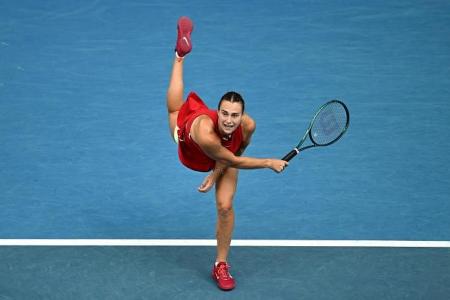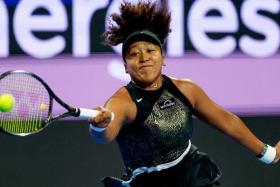Players produce works of art on a rainy Sunday
A lonesome racket lies on the surface of Margaret Court arena. Gently thrown. Forgotten by the defeated Amanda Anisimova who has left the court and soon the Open. The racket lies there like a stringed symbol of despair and frustration. This game hurts all the time.
A day at these courts is never about justice. Nothing feels fair. Adrian Mannarino played so bravely across three five-set matches and his reward is Novak Djokovic who starts their match 6-0, 6-0. The only way the tequila-slugging Frenchman gets to overthrow the Serb is if there’s a drinking contest at changeovers. Ah but Djokovic, tennis’ austere conqueror, doesn’t consume alcohol. Just sips at immortality.
The second week at a Slam is precious as talent starts to thin out slowly. “Nothing is easy,” said the Serb who makes it look precisely like that. Rain falls on a greying Sunday like a sullen drip. The defeated take their pay cheques and leave the premises, suddenly irrelevant to proceedings and yet sometimes forever altered. Maria Timofeeva lost to Marta Kostyuk, but the world No. 170 takes home applause and 8,000 more Instagram followers after an earlier win. “That’s crazy,” she had said.
Grand Slams events in the fourth round remind me of vast, great libraries. There’s still something to suit everyone’s taste. Stefanos Tsitsipas’ one-handed backhand can be erratic but it has such flourish. Mannarino’s racket resembles a set square while Aryna Sabalenka’s racket should be registered at an armoury. The game’s variety has somewhat deteriorated but it hasn’t lost it entirely.
The drama isn’t just in the shots but the anticipation. Organisers want to protect players’ privacy but cameras are aimed everywhere. Anisimova ties her shoelaces, Sabalenka jogs in the corridor. Abba plays, though really these big-hitting women deserve rock. At one point, as Anisimova walks past Sabalenka downstairs, the latter wears a half-smile but the former walks past her without looking. Hardly rudeness, merely a competitor taking refuge in a zone of concentration.
On the next court, Rod Laver creeps quietly into the arena named after him. The cameras catch him and a roar of respect echoes. He’s wondering what the fuss is about, then sights himself on the screen and can barely get himself to wave. He’s all 1.73m of modesty, Sabalenka (1.82m) and Anisimova (1.80m) are towers of talent.
The average height of Singapore men – according to worlddata.info – is 1.73m. The average height of Sunday’s eight fourth-round women is almost 1.75m. Power is a switch only some can produce on easy command. After winning the first set 6-3, Sabalenka was 0-30 while serving at 3-2. Her response was serves at 170kmh (wide), 185, 195 and 185. Match over.
So much we can see – the shots, the faces – and so much we might never know. Kostyuk, the Ukrainian, said she hadn’t been sleeping well for days and who would know this. Everyone is playing for something and struggling with something. “COME ON” – Tsitsipas’ desperate roar seemed to rise from his gut, but his first Grand Slam still eludes him.
The rain tipped down and players waited. Rhythm comes and then flutters away like the bird trapped in the stadium. Fans tittered but players find interruptions foul. Djokovic spoke of the wrestle with greatness and said: “Especially the guys at the top, they want to move the bar at least for 1 or 2 per cent, or try different things, maybe, disguise their flaws in the game and improve them so they’re not as exposed in certain shots.”
Rust, doubt, insecurity, form are usual adversaries in sport but Kostyuk’s fight is unique. In another time, Muhammad Ali, Jackie Robinson and Arthur Ashe took an inspiring stance against bigotry even as they competed. Sport is not always as simple as serving stats and counting winners. Kostyuk thinks people’s attention has slipped away from her nation and she, full of long, thoughtful, answers, is a sneakered ambassador.
“I have to go through all the information (on the war) myself,” explained Kostyuk, “and see what’s the best way to present it to people so they understand it in the easiest way. It’s an extra duty that I have that I don’t think other players have. I mean from other countries.”
No scrap in sport, of course, is equally provocative. Animisova’s great struggle has been to find happiness. Gifted and celebrated, she found fame suffocating and has been out of the game for eight months, for mental health reasons, and at 22 is making a return. The young in sport learn fast. The American quit tennis, went to college, painted to soothe herself and a fourth-round Australian Open place is remarkable.
The thrown racket was not insulting. It was defiance, desperation and perhaps in a way a tennis painter’s respectful surrender to Sabalenka. Who is, of course, a work of art.
Get The New Paper on your phone with the free TNP app. Download from the Apple App Store or Google Play Store now


